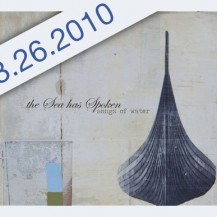Songs of Water’s “The Sea Has Spoken”
I think sometimes, when we judge music, it becomes easy to weigh the value of an album based on its lyrical content. I would go as far to say that often times, the integrity of the instrumentation is overshadowed by the emotions laced within the lyrics. That being said, Songs Of Water’s forthcoming sophomore album, The Sea Has […]
Beth Yeckley
9
out of 10
Songs of Water
The Sea Has Spoken
March 26 2010
Unsigned
I think sometimes, when we judge music, it becomes easy to weigh the value of an album based on its lyrical content. I would go as far to say that often times, the integrity of the instrumentation is overshadowed by the emotions laced within the lyrics. That being said, Songs Of Water’s forthcoming sophomore album, The Sea Has Spoken, is one of the most vibrant musical works I have heard in the last three years. Mostly without lyrics, the music produces a unique language, allowing the violin to tell a story or the mandolin to share a dance; the fiddle to take you on a journey or the percussion to beat beneath your skin.
At first glance, Songs Of Water, which is an eight-member band ranging in talent from the hacky sack to the shruti box, is akin to bands like Old School Freight Train, Nickel Creek, and Punch Brothers. It’s that easily recognizable folk experience, deeply rooted in the belly of a banjo and refined by the elegance of a violin. But the breadth and ability of this band is so much more than that.
The Sea Has Spoken begins with “Everything That Rises,” which starts off with the hammered dulcimer, then layers a foundation for the violin to become the focal point of the song. Played by both Marta Richardson and Luke Skaggs, the violin also becomes the cynosure in songs like “Bread and Circus” and “Sycamore.” But let’s talk more about the hammered dulcimer. It’s described as an “Appalachian folk instrument,” but I don’t think that quite gives it justice. In the right hands, which happen to be Steven Roach’s, the instrument can produce sounds that mimic the robustness of bagpipes, the fluidity of the piano, the dropping of rain on a tin roof, and still be crisp enough to remind you that it’s made of strings.
“Window Seat” is one the songs I was most intrigued by because of the shift in focus towards the guitar and the creation of a flair found in more Spanish-influenced music, like that of Rodrigo y Gabriela. This sound is even more prominent on the song “Luminitsa,” and is due in large part to the influence of Jason Windsor, whose range of play on the strings is remarkable. Also of note, “The Great Russian Catastrophe” is just one of the songs that drifts away from folk and instead carries a more Eastern melody involving the domra (think Russian mandolin). The sound of the strings is so distinct and rich, it leaves the taste of metal on your tongue.
*Editor’s Note: The author would like to clarify that the Spanish-influenced music addressed in songs like “Window Seat” and “Luminitsa.” was due to guitar play by both Jason Windsor and Greg Willette, respectively.
The band is experimental, too, showing signs of curiosity and texture building in songs like, “Beneath The Sleeping City” and “Belly Of The Whale,” which use sounds of shoes striking sidewalks and heavy percussion fused with chime-like noises.
“Sycamore” is the first time we hear lyrics, and it happens again on the final song, “Willow.” Roach’s singing is soft and muffled in static, but becomes clear and high as the song goes on. I love the harmonizing of Sarah Stephens, and was pleasantly surprised to hear the vocals drape over the instrumentation without tainting the music.
As you listen to The Sea Has Spoken, you’ll find that the depth of each song creates a kaleidoscope effect. Wherein, at one moment you feel that you are walking on a cliff against the sea, and the next you find yourself meandering through a circus tent. I love lyrics as much as the next person, but find myself incredibly moved and enraptured by the work of Songs Of Water.
